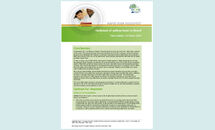Rapid risk assessment: Outbreak of yellow fever in Brazil, Third update.
In September 2017, the Ministry of Health in Brazil declared the end of the 2016–2017 yellow fever outbreak in the country. The upsurge of human cases since December 2017 and the continuous non-human primate epizootics since September 2017 indicate a continued or resumed increase in yellow fever virus circulation in Brazil. Since January 2018, most of the yellow fever cases have been reported from São Paulo, Rio de Janeiro and Minas Gerais states.
Executive Summary
Conclusions
In September 2017, the Ministry of Health in Brazil declared the end of the 2016–2017 yellow fever outbreak in the country. The upsurge of human cases since December 2017 and the continuous non-human primate epizootics since September 2017 indicate a continued or resumed increase in yellow fever virus circulation in Brazil. Since January 2018, most of the yellow fever cases have been reported from São Paulo, Rio de Janeiro and Minas Gerais states.
To date, an urban cycle of yellow fever transmission by Aedes aegypti (or Aedes albopictus) has not been documented in Brazil. However, the detection of non-human primate cases in the vicinity of the metropolitan regions of São Paulo and Rio de Janeiro remains of concern, especially in areas with suboptimal vaccination coverage. This is particularly relevant for municipalities that were previously not considered at risk for yellow fever and where routine yellow fever vaccination was not indicated. Therefore, the possibility of an urban cycle of yellow fever transmission remains.
Since January 2018, Brazilian national health authorities have been intensifying and extending vaccination activities through mass yellow fever vaccination campaigns in Rio de Janeiro and São Paulo states. Additional vaccination campaigns have been conducted in Bahia State since February 2018. The overall target population was around 22.7 million people. According to the Brazilian authorities, as of 13 March 2018, preliminary results of the mass yellow fever vaccination campaign indicate that 17.5 million people have been vaccinated.
The risk of yellow fever importation and subsequent transmission in continental Europe is currently very low because the risk of the virus being introduced by viraemic travellers into an area with established, competent and active mosquito vector population is very low.
Options for response
Advice to travellers
EU/EEA citizens who travel to, or live in areas at risk of yellow fever in Brazil and other countries in South America are advised to:
• Check their vaccination status and get vaccinated if necessary, in accordance with national and WHO recommendations. Vaccination against yellow fever is recommended by WHO for people visiting or living in yellow fever risk areas, from nine months of age and without contraindications [1-3]. An individual risk– benefit analysis should be conducted by professionals in tropical or travel medicine centres prior to vaccination, taking into account the period, destination, duration of travel and likelihood of being bitten by mosquitoes as well as individual risk factors for adverse events following yellow fever vaccination.
• Take measures to prevent mosquito bites indoors and outdoors, especially between sunrise and sunset when mosquito vectors are most active. This also apply to places such as large recreational areas and parks, botanical gardens and natural reserves. The measures include:
− the use of mosquito repellent in accordance with the instructions indicated on the product label;
− wearing long-sleeved shirts and long trousers;
− sleeping or resting in screened/air-conditioned rooms or using mosquito nets at night and during the day.
International travellers returning from affected areas may be requested to show proof of yellow fever vaccination (or a contraindication certificate) when entering countries or territories infested with Aedes aegypti mosquitoes.
Vaccination requirements and recommendations for international travellers are available from the World Health Organization’s website [2,4-10].
Advice to health professionals
Physicians, health professionals and travel health clinics should be provided with, or have access to regularly updated information on areas with ongoing yellow fever transmission and should consider yellow fever in the differential diagnoses for illnesses in unvaccinated travellers returning from at-risk areas. To reduce the risk of adverse events following immunisation, healthcare practitioners responsible for yellow fever vaccinations should be aware of the contraindications and follow the manufacturers’ advice on precautions before administering yellow fever vaccine [3,11].
Option for EU Overseas Countries and Territories and Outermost Regions with presence of Aedes aegypti
In the EU Overseas Countries and Territories and EU Outermost Regions where Aedes aegypti is established or has been introduced, verification of yellow fever vaccination status should be considered for travellers coming from Brazil in order to reduce the risk of yellow fever importation and subsequent spread.
Options for the safety of substances of human origin (SoHO)
The risks and options for the safety of substances of human origin (SoHO) remain the same as in the second updated ECDC rapid risk assessment, published on 18 January 2018 [12].
Download







